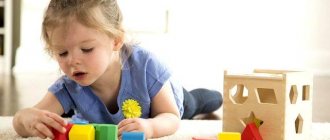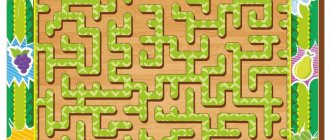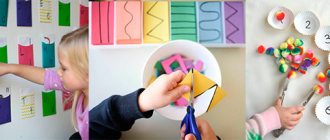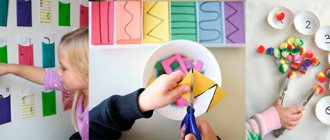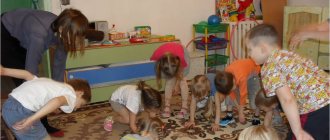Development of memory in preschool children. It is impossible to imagine a mentally healthy person without memory. This simply cannot happen. After all, memory is a tool with which an individual can apply his experience and rely on previously acquired knowledge. It is important to teach your memory to work correctly so that it does not fail. For this, a fertile period will be preschool age, when the emergence and development of mental activity occurs.
Features of memory development in a preschool child
Each time period of a person’s life is different from others, because at each stage new knowledge comes. In addition, the ability to remember depends on a person’s physical and mental abilities. In preschool age, memory is excellent, the child literally grasps everything on the go. Everything he learns interests him; this is the process of cognition. But what seemed uninteresting will remain overboard.
Memory is a meaningful action. If a child does not understand something, he will not remember it. Involuntarily, things that touched and impressed the child are remembered. And in order to remember something that, in a child’s opinion, is not at all interesting, you need to work hard. Meanwhile, the child who is already learning to analyze, compare, generalize, and masters other operations of mental activity remembers better.
Bright pictures are very important for children; their eyes catch colorful illustrations, and their brain forces them to put these images in their memory. Movement also helps memory. A child cannot be passive, so outdoor games and exercises help develop his memory.
The first important stage in the period of growing up of a preschooler appears at the age of four. If before this period there were first actions that gave rise to memorization, then in the middle group of kindergarten the child can already remember the words spoken to him and perform some actions based on instructions. He can even plan some actions himself based on the remembered material, and first of all, the support for these memories will be the child’s personal observations.
At the age of five, a preschooler comprehends logical memorization; adults help him with this when they give some instructions or explanations for any actions. During this period, the interaction of mental operations is important.
Additional recommendations
If you have decided to develop the memory of a preschooler, then you should not limit yourself to direct methods. There are a number of conventions that have a significant impact on brain function, which can significantly harm the effectiveness of training. Therefore, it is very important to pay attention to them, as well as bring all the necessary changes into the child’s life.
Daily regime
Establishing the correct daily routine is an important condition, without which it will not be possible to develop memory. A child needs to sleep at least 8 hours every night, and he must have enough free time during the day or evening to devote to his favorite entertainment.
It is important to plan the day for your child in such a way that he does not experience overwork. Even if you need to perform a difficult task for a very long time, you must take short rest breaks. You should also make sure that the baby does not suffer from idleness and is not lazy.
Emotions
The emotional component is of greatest importance in the life of a preschooler. It is on her that the future of the baby, the characteristics of his development and the perception of the world around him depend. Parents should devote as much time to him as needed. Lack of communication is detrimental to a child’s psyche.
You need to spend a lot of time with a preschooler, give advice, show care, and help if necessary. He must feel parental love. Only in this way will he have the desire to develop, be a good person and communicate with the people around him.
Nutrition
Almost every parent prohibits their child from eating junk food. For this reason, children make scandals, cry, get very offended, and the most desperate ones simply run away from adults, without thinking about the consequences. Therefore, you need to prepare the child by explaining why certain foods cannot be eaten.
Fatty or fried foods, fast food, carbonated drinks should be excluded from the diet, and the amount of sweets consumed with baked goods should be limited. The most beneficial will be: nuts, grains, fruits, vegetables, herbs, mushrooms, cheese, white meat, seafood, fish and liver.
Physical activity
Movement is life. It even affects the level of intellectual development and the quality of memorization. This is due to the fact that physical activity increases blood circulation, which increases the efficiency of the brain. At the same time, metabolism is normalized, the likelihood of the occurrence of certain diseases is reduced, and mental stress disappears.
For preschool children, light jogging in the park, dancing, yoga, and swimming are suitable. It is acceptable to engage in other sports, but when choosing, be sure to take into account the child’s personal wishes.
It is recommended to spend more time outdoors. This is especially useful for children's bodies. With daily walks, memory development during preschool age will become even more effective.
Types of memory
Development of memory in preschool children. There are several types of memory.
- motor,
- emotional,
- verbal-logical,
- figurative.
In turn, it is necessary to note involuntary memory, when images and objects are remembered as if by themselves, without any effort, and voluntary, when a diligent process of memorization is underway. Involuntary memory is typical for younger preschoolers. Older preschoolers are already beginning to master voluntary memorization.
Emotional development of a preschooler
What types of memory are there?
The information that is reflected in memory may be different. This difference lies in the involvement of different senses (analyzers) when perceiving it. There is no single and indivisible memory. In reality, human memory consists of three main components. These are the so-called types of human memory. Each of them is important at a certain stage of memorization. Only the coordinated and harmonious work of all “parts of memory” allows each of us to acquire new knowledge, assimilate a variety of information and remember past events.
The following types of memory are distinguished:
- visual (memorizing images and phenomena seen);
- auditory (remembering heard information);
- olfactory (memory for smells);
- tactile (reflection of tactile sensations in memory);
- gustatory (memorizing taste sensations).
If we take into account the nature of the child’s mental activity associated with the process of memorization, then memory can be:
- Motor - aimed at remembering movements and their sequences. Plays an important role in the formation of walking, running, writing, labor and other motor skills.
- Figurative - represents a reflection in memory of objects and phenomena that were perceived through the senses (visual, auditory images). It is figurative memory that is predominant in preschoolers.
- Emotional - responsible for remembering experiences. Thanks to this, having recalled some life events, a person can again feel the emotions associated with it (joy, shame, fear). This type of memory serves as a support for the moral education of preschool children.
- Verbal-logical - in this case, the object of memorization is thoughts and concepts. In this case, information can be reproduced both verbatim and in a verbal form that is more accessible to humans for understanding.
Depending on how long information will be stored, memory can be short-term, long-term and operational. Short-term memory allows you to store and reproduce information immediately after it is perceived.
Thanks to RAM, it is possible to retain certain knowledge for the time necessary to carry out any activity. If this knowledge, after a person achieves a goal, loses its significance, then it is forgotten.
Long-term memory is responsible for storing information for a long time. Thanks to this, the strength of memorization of the knowledge and skills acquired by a person is ensured.
According to the degree of human activity in the process of memorization and reproduction, voluntary and involuntary memory are distinguished. Involuntary memorization occurs when a person, in the process of some activity, without much effort, learns useful and interesting information. Voluntary memorization presupposes the presence of a goal to assimilate this or that material and is impossible without the volitional efforts of a person.
Depending on the orientation of the child’s personality, memory is characterized by individual characteristics: memory volume, accuracy of reproduction, speed of forgetting. The individuality of children's memory is manifested in the fact that, observing the same phenomenon, different children will remember an unequal number of details, and not everyone will be able to tell well about what they saw over time.
Reproduction forms
Forms of reproduction can also be divided into groups.
- The simplest thing is recognition. If a person has seen or heard something before, he will certainly recognize it.
- The second form is memory. For memory it is not important to see the object. It is important to remember its signs.
- The third form is recollection. In this case, remembering can be difficult; in order to remember, you need to make an effort and character.
- The fourth form is forgetting. It is impossible to remember everything all the time. Forgetting is the case when the brain refuses to remember the characteristics of an object or replaces one object or phenomenon with others because recognition is blurred.
In preschoolers, figurative memory dominates. He remembers the signs of an object and phenomenon, if they are vivid and catch his imagination. Can remember minor details, but most importantly, forget important things.
In addition, when working with children, you need to remember another feature of the children's brain: selectivity. Everything that is interesting to a preschooler is remembered without difficulty. Everything that is boring and uninteresting is immediately forgotten, because there is no fixation on its main features.
The third feature: repetition is the mother of learning, teachers say following the author of the historical phrase. If a child repeats the same actions over and over again, he automatically remembers.
The fourth distinctive feature of a preschooler’s memory is that emotional influence leads to memorization. What touches you cannot help but leave a trace in your memory.
When the amount of information accumulates, with the development of perception, the child is able to master coherent and systemic ideas. And the next step will be meaningful operation of the acquired knowledge.
How does a child's memory work?
A preschool child is active in learning about the world around him, looking for answers to his questions, trying to get as much information as possible about what interests him. New knowledge is remembered and stored, and when the need arises, it is reproduced. This form of reflection of experience is called memory.
The development of memory in preschool children is inextricably linked with the formation of other cognitive processes. Thus, recognition of objects and phenomena in perception is possible only if they have already been perceived in the past, and information about them is imprinted in memory. On the other hand, the process of memorization is the establishment of connections between what is observed and perceived directly at this moment and what was in the child’s experience earlier.
Objects and phenomena can be reflected in memory, both those to which attention is directed, and those that come into the child’s field of vision by chance, but evoke an emotional response in him. That is why the quality of memorization of various types of information is influenced by the child’s personal characteristics: his interests, mood, preferred types of activities.
The strength of memorization is influenced by the degree of comprehension of the material. Meaningful memorization consists in the fact that a person tries to correlate new information with that which was in his experience earlier, due to which knowledge is systematized.
When learning by rote, a person does not understand the meaning of the material.
Norms of memory development in preschoolers
For a specific age stage there are different norms.
- Up to a year - motor memory, there are reflexes, memorization at the level of emotions.
- 1-2 years – development of the nervous system, figurative memorization.
- 2-4 years – development of mechanical memory, memorization and logical thinking skills, recognition predominates, interest is important for memorization.
- 4-5 years – involuntary memorization, voluntary begins, recall prevails.
- 5-7 years - arbitrary. The volume of normal memorization is from 8 out of 10 items.
Developmental techniques for children
Minerals, vitamins and amino acids that help improve memory
- Vitamin C is the real king among vitamins, which is capable of increasing the mental activity of the brain, along with its other great abilities to work wonders in our body. Every child probably knows where vitamin C is found. And of course these are bell peppers, cabbage (especially sauerkraut), spinach, broccoli, many berries (currants, raspberries), rose hips, and of course citrus fruits.
- Choline, or vitamin B4, is used by the body to produce the neurotransmitter acetylcholine, which is essential for the normal functioning of all cells. Choline is especially important for brain function, as it affects areas of the brain responsible for memory functions and learning throughout life. Choline is also essential for transporting nutrients throughout the body, including the brain. Eggs are a rich source of choline and other sources include beef, cauliflower, wheat, peanuts and lettuce. Similar to taurine, choline is usually fortified in milk powder. Products containing choline - meat, milk, soy, egg yolk, cauliflower. These foods also contain other B vitamins, which also have a beneficial effect on brain function.
- Taurine is an amino acid that supports neurological development and increases memory power in children. Taurine is also believed to have antioxidant properties that help brain function. Taurine is found in meat, fish and breast milk. Most commercially produced dry formulas are fortified with taurine, since the body of young children deprived of breast milk does not have the ability to synthesize taurine from their diet. Regular cow's milk does not provide enough taurine.
- Folic acid reduces homocysteine levels, elevated levels of which have a bad effect on memory. Foods rich in folic acid include whole grains, soy, spinach, green peas, broccoli and oranges. There is ample research evidence to support the use of folic acid as a memory booster.
- Vitamin K (phylloquinone) strengthens the walls of blood vessels, protects them from destruction and gives them elasticity, prevents the development of atherosclerosis of all vessels, including brain vessels. It is known that this substance improves memory and activates mental activity. This vitamin is found in foods of plant origin - spinach, white cabbage, green tea and black tea, tomatoes, broccoli, dates, watercress, legumes and many others. etc. Among animal products, vitamin K contains beef liver, cod liver, eggs, and goat milk.
- Omega 3. The benefits of this polyunsaturated fatty acid are that it promotes brain development. Food sources of omega-3 fatty acids include fish oil and some vegetable or nut oils. Tuna, salmon and herring are also animal sources of Omega 3s. Peanuts, walnuts and almonds are also common sources of this fatty acid. For children who do not like to eat fish or nuts, fish oil is available in capsules or in the form of gelatin figures with different flavors.
- Magnesium is necessary for our body and brain, as it is an anti-stress substance, participates in the metabolism of fats, carbohydrates, proteins, transmission of nerve impulses, cleanses the body of toxins, and so on. This trace element improves memory and attention. Magnesium is found in almost all nuts, cereals, sprouted cereal grains, mustard, bananas, seaweed and legumes. Among vegetables, magnesium is found in sufficient quantities in broccoli, beets, avacados, onions and greens. Cocoa fruits and, accordingly, dark chocolate are also rich in magnesium.
- Selenium is a powerful antioxidant necessary for strengthening memory, as it protects nerve cells from their destruction. Selenium is found in herring, crab, garlic, oregano, olive oil, shrimp, porcini mushrooms, wheat germ and Brazil nuts.
Parents should also know that if a child has serious memory problems and it is very difficult for him to remember, it may be worth contacting a neuropsychologist.
How to measure a child's memory
Development of memory in preschool children. You can measure your child's memory using special tests.
Visual memory
The child is invited to look at the pictures. It will take one and a half minutes to open. Then the child is asked to draw from memory what he saw.
If the child correctly drew most of the objects, his memory is good. If not, there are memory problems.
Another option is to show the child pictures, ten in total. Then they ask him to name the objects he saw.
If the child correctly named more than 8 pictures, his memory is good. If you made a mistake about five times, the result is average. If you made more than five mistakes, then your memory is bad.
Auditory memory
The teacher calls out the numbers, the child must repeat after him. If the child names at least 5 numbers from a series correctly, then his memory is good.
Recognition test
The child is shown a picture depicting certain objects. Then he is asked to find these objects in a large picture.
If a child managed to find at least eight out of 10 objects, his memory is good. Made more than five mistakes - the result was weak.
Simple workouts
Achieving memory development in preschoolers is not as difficult as it might seem at first glance. You just need to provide the child with comfortable conditions, as well as put into practice the techniques you like, but do this in such a way that the child does not experience negative emotions during the training process. To fulfill the last condition, it is necessary to take into account the interests of children, giving them the right to vote in the choice of technology for development. It’s best to start with methods that are simpler and more accessible in everyday life.
Poems
At school, many children begin to dislike poems, because... It is extremely difficult for them to cope with memorizing long poetic works. If you learn interesting rhymes before school, then this outcome can be prevented. At the same time, memorizing even light quatrains will be beneficial, making the child’s memory much stronger.
It is important that the child himself likes the poem. At the same time, parents should in every possible way encourage his desire to learn a few more lines. It’s enough to simply praise the baby, saying how great he is. It is best to approach learning poems at the age of 5-6 years.
Memorizing information
Simple memorization is a popular method for schoolchildren to memorize important information. But it can be extremely effective for preschoolers too. This is due to the fact that with active memorization, the child’s memory is seriously trained, becoming stronger. For these purposes, you can select short, simple rules or interesting facts. The child will have to reproduce the memorized text as accurately as possible.
It is not recommended to get carried away with this method, because... it may have a negative impact on future learning. If a child gets used to memorization, then involuntary memory will work less effectively, and the desire to understand and understand the subject will be blocked by attempts at simple memorization.
Reading
Literature can also be very useful in developing memory. If the child has already learned to read, then he can be given simple books that he can master. Preschoolers who cannot yet read even a short story on their own should be helped by their parents. You just need to read any interesting book to your baby before bed or during the day.
After reading, parents should discuss the story they read with their child. You can ask for comments on certain events, tell your impressions, or offer to find references to certain things on the pages of the work. It is also advisable to give the child the task of briefly retelling the story he heard.
What I saw
A very simple method to strengthen your memory. It represents an interesting interaction between parents and child. The idea is that adults ask the child questions or ask him to talk about any recent event. For example, going to the circus or an evening walk. You need to choose activities that evoke a lot of emotions in your child.
With such discussions, the child will develop memory, sociability, outlook, as well as a desire to show increased attention to detail. It is important to ask questions with motivation, so that the child understands why he is being asked about this, and the conversation does not resemble an interrogation.
Associations
One of the most effective mnemonic techniques is association. They are very often used by children to memorize information, but when used purposefully, this method leads to memory strengthening. Its essence is to create associative chains in which each item is connected to each other by a certain characteristic. This memorization allows you to retain the maximum amount of information in your memory.
It is recommended to use the technique for preschoolers 6-7 years old. Younger children will not be able to fully use all the conditions of associative chains.
Scientists have proven that 70% of information received is forgotten the very next day, another 25% is forgotten within a month. It turns out that of the memories that are not further consolidated, only 5% remains in the head.
Exercises and games to develop memory
Remembering that it is easier for a preschooler to remember things that he understands, you need to build the learning process through play, based on motor activity and emotions caused by interest.
Development of figurative memory
Development of memory in preschool children. The child’s ability to involuntarily memorize objects can be used in the “Classification” game. In this case, the child is offered several pictures with images of some objects. The child needs to arrange the illustrations into groups. For example, he must arrange pieces of furniture into “rooms”: bedroom, living room, kitchen, bathroom. Or there are pictures of animals. The child should put domestic animals in the “house” and wild animals in the “forest”.
The game “Shop” will help to develop figurative memory. The child shopper “does” the shopping, who must put into a basket the items he was told to “buy.”
Development of imagination in preschool children
Development of auditory memory
When a child hears some information, he mentally processes it and only then takes action. What if the child does not know how to listen and hear? Then there is no need to talk about his future success at school. Therefore, it is very important for preschoolers to develop auditory memory. You can use these exercises.
Verbal relay race
In this game, the leader names a word. The child must repeat the word that the leader said and say his own word. Then it’s the presenter’s turn. He names these two words and adds a third. Child's turn: he repeats all the words and adds a fourth word. It is desirable that the words be on a specific topic: “Summer”, “Vegetables”, “Transport”, “Dishes”, etc. The one who made a mistake, knocked down the verbal chain, lost.
Game of colors
In this exercise, the child must color the picture. But before that, he listens to a text passage that talks about the plot in the picture and names the colors. For example, in the picture there is a house with a brown roof, red apples grow on the tree house, and blue flowers grow in the clearing. In order to color the picture correctly, the child must remember the text.
Tact
Clap your hands or knock with a hammer, beating time. The child must repeat the sound combination.
Memory
Memory is a property of human consciousness, the renewal in the consciousness of those images that once made an impression. Not a single mental function can function without the participation of memory.
Definition 1
Memory is a form of mental reflection of experience and underlies personal experience, training and education, the acquisition of knowledge, and the formation of skills.
The most favorable age for memory development is preschool childhood. Lev Semenovich Vygotsky believed that memory is the dominant function and goes a long way in its development.
Are you an expert in this subject area? We invite you to become the author of the Directory Working Conditions
Development of visual memory
Development of memory in preschool children. Bright pictures attract children's attention, but are kids able to retain the image in memory? To develop their abilities, you can invite preschoolers to play the following games:
"Restore the pattern"
A pattern is laid out on the surface using painted parts. The child remembers it. Then the child is asked to lay out the same pattern from memory.
"Scout"
There are objects on the table. The child looks at them and remembers what and where it is. Then the child turns away, and some objects are swapped. The child must name the objects that were moved.
"Walk"
While walking, the child sees many colors and objects, he involuntarily remembers what attracted his attention. An adult should help focus attention. After the walk, you can ask your child to draw what he remembers.
How to develop a preschooler's memory
A child of preschool age is active in exploring objects and phenomena of the surrounding world; the task of an adult is to direct his perception, to ensure that he receives a variety of information about the subject that interests him. For example, in order to remember the characteristics of an apple, a child must determine its shape, color (use vision), touch it (get tactile sensations), taste it (use taste buds), while an adult will supplement this information with a story about how apples are grown.
The child’s participation in receiving information ensures the strength of its memorization. The material that is intended for memorization must be significant in the child’s activities.
An important role in a preschooler’s memorization is played by his interest in the observed object. Therefore, in the education of preschoolers, creating motivation for activity plays a special role. To do this, when offering a task to a child, you need to try to create an imaginary game situation, evoke a desire to make a discovery, and gain satisfaction from success. For example, a game where the child needs to help guide forest friends across the road will help you remember the colors of traffic lights. Such activity is associated with the child’s emotional inclusion in a situation that requires him to memorize the material.
If an adult sets a child the task of remembering material, then it needs to be done in such a way that it is clear to him why it is needed. Conscious memorization and reproduction of information is already the beginning of the development of arbitrariness of memory. Such purposeful assimilation of material occurs in the process of educational games.
The development of a preschooler's memory is facilitated by adherence to a daily routine. This involves performing certain actions at the same time every day. Such frequent repetition ensures the strength of involuntary memorization.
Thus, the development of memory in preschoolers requires:
- constantly involving the child in activities that involve memorizing and reproducing material;
- creating conditions for the child’s activity and independence in cognitive activity;
- establishing a connection between what is being studied and the needs and interests of the child;
- inclusion of new information about objects and phenomena intended for memorization into the system of existing knowledge.
Development of motor memory
To develop motor memory, you can play “puppet”. The child stands calmly, and the adult controls his arms and legs, forcing him to go right, left, forward. Then the child is asked to repeat the movements from memory.
You can also use the game “Do as I do.” The teacher makes the movements, the child repeats after him.
Developmental activities for preschool children
Features of organizing educational activities for preschoolers
Since memorization in early preschool age is still involuntary, one of the main tasks in this period is teaching the child voluntary memorization. This will play an invaluable role in his future; in particular - for schooling. The child will be able to effectively control the thought process and remember the material offered to him in the shortest possible time. In addition, preschoolers, unlike older children, memorize information mechanically, without building certain connections that structure the material.
Mnemonics for kids - how it works
Thus, another priority task of developmental activities is the child’s mastery of elementary logical laws.
Classes to develop memory are necessary for a child, primarily because in the preschool period this process is formed most effectively. The child very effectively assimilates everything that the parent puts into him and adults can only properly guide and structure his cognitive activity. Developed memory is also a condition for preparing a child for school. Without the ability to remember information, the child will not properly perceive the material offered to him.
Definition - what is memory
It is necessary to develop a child’s memory in the process of specially organized activities and using special techniques. They allow you to successfully develop various types and forms of memory, as well as consolidate them and allow the child to successfully apply them in practice.
Development of arbitrary logical memory
The ability to classify leads to the development of arbitrary logical memory, so it is important to give children exercises where they must use methods of classification, analysis, comparison and generalization.
Didactic game "Cards"
Children are asked to select images based on specific characteristics and arrange them in piles. For example, from pictures with birds and animals, you need to put pictures with birds in one group, and pictures with animals in another. Themes for the game can be different: sports, furniture, seasons, plants, etc.
"Twins"
Among different pictures, the child must find two identical ones.
Why is it important to develop memory in children from an early age?
It’s not for nothing that newborn children are compared to a blank sheet of paper on which nothing has yet been written. After all, memory is memories of past experiences, and babies don’t have them yet. But as they grow up, literally from the first months, babies accumulate different feelings, sensations, abilities and skills, many of which will last a lifetime.
Today, people have come up with many ways to “save” important dates, events, lists, etc.: from convenient planners and checklists to reminder applications on their phones and computers. This is understandable - after all, it is much easier than storing information in your head. This is why it is so important to “pump up” your memory on your own. This will help your child:
- easy to remember facts, events, texts, etc.;
- do well in school;
- think outside the box;
- and even find a way out of difficult life situations!
You just need to remember that “poor” memory in children is often confused with underdeveloped memory. And this can be corrected by regular exercise and training.
Development of long-term memory
Development of memory in preschool children. To develop long-term memory, you need to teach a child not only to recognize, but also to reproduce information. Long-term memory is impossible without expanding the horizons of a preschooler. In this case, exercises with texts and illustrations help.
Preschoolers are offered several pictures depicting animals and various objects. And there is a suggestion: remember all the animals, for example. Or remember all the dishes that are in the pictures and then name them.
A good option would be to compare pictures that differ in minor details.
Involuntary memory
Basically, a preschooler's memory is involuntary. More often than not, the child does not set a goal to remember anything. Memorization occurs independently of consciousness, it is carried out in activity and depends on the nature of the individual. The preschooler remembers what he paid attention to in the activity, what made an impression on him.
Involuntary memorization of objects and words depends on the child’s active action in relation to them - how he perceives them, thinks about them, groups them. When looking at pictures and illustrations, the child remembers worse than when asked to put them in certain places or distribute them.
Thus, for younger schoolchildren, the only form of memory work is involuntary memorization and involuntary reproduction. Since he cannot yet set a goal for himself - to remember or remember anything.
Methods for developing tactile memory
Tactile memory is a person’s ability to remember the sensations of touching a particular object. To develop tactile memory you will need the following exercises:
"Find by touch"
The child is asked to choose one from a variety of objects based on specific tactile characteristics. For example, a child is told that this object is soft and fluffy. Or rough, prickly.
"Game with mood"
The child has associations about objects. If an object is soft and pleasant to the touch, then this object is in a good mood. Which object is in a sad mood? Or evil? The child, relying on tactile sensations, selects objects.
"Tales with tactile details"
In this case, the child participates in a theatrical production, where the plot of a fairy tale is heard, and all the characters and objects surrounding them can be touched and determined what they are: soft, rough, hard, prickly, etc.
Games to develop fine motor skills in children
The role of literature in the formation of memory of preschool children
One of the most effective methods of achieving the desired result in developing memory in preschool children is reading fairy tales and other children's literature, as well as listening to children's audio books. Reading fairy tales and stories is very important for the development of memory in preschool children. When choosing fiction for a child, you need to make sure that it is accessible to his understanding, has a connection with his life, and contains pictures that correspond to the meaning of the text. Preschoolers enjoy listening to stories about children and commenting on illustrations, because it is close to their experience. Thus, based on listening, the opportunity to examine the image, to emotionally experience the events described, a holistic image is created in the child’s mind, which is easily remembered.
If the content of a fairy tale or story is interesting to the child, you can invite him to answer questions or retell the text based on the illustrations. Reproducing new information for an adult is also a way to develop a child’s memorization skills. Repeated repetition ensures the strength of storing the material in memory.
Memory impairments and their causes
Experts distinguish two main types of disorders:
- quantitative,
- quality.
Quantitative disorders are a weakening of memory, loss of any fragments. With high-quality ones, false memories and fantasies come first, replacing reality.
The causes of memory impairment in children can be:
- mental retardation, often congenital,
- trauma, physical or mental,
- an atmosphere that is not comfortable for the child, where fear displaces everything from the child’s head,
- soreness of the body, including vitamin deficiency.
What is memory
All events, experiences, feelings and emotions that every person feels during his life are necessarily reflected in his personality.
Memory is our amazing and mysterious property. This is remembering, preserving and reproducing past experiences. Why do we remember snippets of songs from distant childhood, but sometimes we forget what we went to the next room for? Why does our brain store telephone numbers or dates that are no longer relevant? One remembers faces better, the other remembers names. What does this depend on?
It's all about what kind of memory we use.
What affects the development of memory in a child
Development of memory in preschool children. In order for a child’s memory to develop, you need to pay attention to the following factors:
Nutrition
The diet should be varied, healthy foods and vitamins should be included in the diet. There must be meat and vegetable products, fish, herbs, and fruits.
Healthy eating: menu for every day
Healthy lifestyle
There must be a daily routine in which you need to devote time to both walks and useful activities. The child should go to bed at a specific time and get up at a specific time. Let the child participate in a sports section or attend a development club.
Development taking into account the age characteristics of the child
Parents must understand that the child must direct his energy in the right direction. However, you should not overtire your preschooler, otherwise you may end up with constant fatigue syndrome. It’s good if developmental classes take place in a kindergarten. It is impossible to overwork a child by enrolling him in several sections and clubs at once.
Exercises for memory development in children: VIDEO
Umnasia memory courses
On our website, your child will be able not only to exercise on a simulator or participate in Olympiads, but also to improve such an important skill as “MEMORY”. The program consists of four courses: 1. “How to learn poetry quickly and well”; 2. “How to remember foreign words, names and faces”; 3. “How to quickly and correctly remember information”; 4. “Practical mnemonics.”
Choose the most interesting one or upgrade all types of memory! (when purchasing a set of 2 or 4 courses you will receive a nice gift)
Memory development in children 6-13 years old
We develop the ability to quickly memorize and retain a large amount of necessary information for a long time
find out more
Preschooler memory development
Features of memory development in infancy.
At the first stage of life, memory appears in an elementary form - imprinting and recognizing influences that are vital for the body.
The first impressions of a newborn, which are recorded in memory, can be unconscious (lighting, air or bathing water temperature, etc.) and social (voice, mother’s face, household items). This leads to the accumulation of personal experience, and new forms of behavior are mastered. Figurative memory (in elementary form) appears immediately after birth: in the 1st month. life - the same type of reaction to a repeated stimulus, for 3-4 months. - an image of an object is formed (the foundation of figurative memory): recognizes the mother’s voice and face, which helps to establish contacts with adults, recognizes objects related to feeding; at 5 months distinguishes people by their voice, 6 months. - highlights favorite toy, 7-8 months. - recognition of an object is mediated by a word (“Where...?”), 8-9 months. - recognizes a familiar person after 2-3 weeks of separation. By 12 months - distinguishes a melody if it evokes positive emotions; at the request of an adult, performs simple movements (“hands on”, waves his hand when parting). Recognition of objects usually occurs based on one insignificant feature, but minor changes in appearance can lead to non-recognition of the object.
Gradually, the period between memorization and recognition lengthens. In the form of free recollection, figurative memory is observed only at the beginning of the 2nd year of life.
Motor memory - its manifestation is indicated by the formed reflex to the feeding position (in the “under the breast” position - sucking movements). Activates in the 2nd half of the year, when it begins: active manipulation of objects; crawling and attempts to walk. Emotional memory - manifests itself more clearly in the 2nd half of the 1st year of life, when the child experiences certain emotions when encountering certain objects or situations. The first prerequisites for verbal memory appear by the end of the 1st year of life, when an adult associates a word with an object, their signs, actions, properties.
Thus, memory in infancy is not yet an independent process, but is included in perception and sensation and is involuntary.
Features of memory development at an early age. As a result of expanding familiarization with the objective world, the child begins a new stage in the development of memory. The child begins to master objective actions in accordance with their function and purpose - masters new movements and skills. All this leads to the fact that memory becomes more flexible and mobile.
The child develops ideas about objects, their distance, size, direction of movement, actions performed, and events. The child already recognizes an object regardless of the situation and identifies it by its essential features.
At the beginning of the 2nd year of life, the child’s memory is separated from the process of perception, i.e. becomes an independent mental process. The ability to reproduce an object in its absence arises. The interval between memorization and recognition lengthens (by the end of the 1st year of life, the child recognizes his own face after a 2-3 week separation, at the 2nd year of life - 1.5 - 2 months; at 3 years - after 1 year).
By the end of early childhood, the volume and strength of children's memory sharply increases. The main feature of memory during this period is its unintentional nature, i.e. everything is remembered as if “by itself.” Basically, young children remember what is, to one degree or another, included in their play or some practical activity, what they directly need and are interested in, and what had an emotional impact on them and made a deep impression.
Verbal-semantic memory begins to develop intensively, as the child already begins to respond to the meaning of the word, and not to its rhythmic and melodic structure. In the 3rd year of life, the child understands every single word of the phrase, and his active and passive vocabulary expands.
The memory of young children is characterized by great plasticity; they remember quickly and easily. Unlike adults, a child's memorization is rapid, but often chaotic. A child can remember complex material or retain in his memory random events, insignificant (in the opinion of adults) details, snatches of adult conversations, individual phrases and expressions, the meaning of which may not be entirely clear to him. The plasticity of a child's memory often leads to the fact that he can reproduce unnecessary material that unexpectedly pops up in the child's memory. This is also due to the fact that memorization and reproduction have not yet become completely independent processes, but are only a way of mastering language.
The objective basis for memorizing various words and phrases, nursery rhymes, poems, however, continues to be the rhyme and rhythmic structure of this material. The characteristic features of early children's ideas are their: unsystematic nature; unity; immobility; patchiness (fragmentality). The child “jumps” from one feature of an object to another, from one component of the situation to another. What is often retained in memory is what is unimportant rather than what is essential. Ideas are primarily associated with surrounding household items, toys, objects of animate and inanimate nature, space and time, etc.
The main directions of memory development in preschool age. Throughout preschool childhood, significant changes occur in children's memory. Continuous expansion of horizons, the desire to master knowledge, skills and abilities, and the complication of activities and relationships with adults lead to both quantitative changes in the child’s memory and to those qualitative transformations that ultimately determine the further development of memory. Preschool age is characterized by intensive development of the ability to remember and reproduce.
Involuntary memory and conditions for its development. Throughout preschool age, involuntary memory predominates. The child most often does not set conscious goals for himself to remember anything. Memorization and recollection occur independently of his will and consciousness. They are carried out in activity and depend on its nature. The child remembers what was paid attention to in the activity, what impressed him, what was interesting.
In younger preschoolers, involuntary memorization and involuntary reproduction are the only form of memory work. The child cannot yet set himself the goal of remembering or remembering something, and certainly does not use special techniques for this. The preschooler retains the dependence of memorizing the material on the following features: emotional appeal, brightness, sound, intermittent action, movement (mechanical toys), contrast, unusualness, etc. That is why kids remember for a long time the characters that teachers include in surprise moments. The unexpectedness of the appearance and novelty of the toy, combined with the emotionality of the teacher, leave a deep imprint in the child’s memory.
Until 3-4 years of age, a child’s memory is predominantly unintentional. The child not only does not yet know how to set himself the goal of remembering - to remember, but also does not accept the mnemonic task coming from outside. He also does not master those methods and techniques that would allow him to deliberately carry out the processes of memorization and reproduction. It is involuntary memorization that provides him with a variety of knowledge about objects and phenomena of the surrounding world, their properties, connections, about people, their relationships and activities.
Something that is repeated many times can be imprinted involuntarily. What the child acts with, what is included in his activity, is involuntarily imprinted. Speech is of great importance. The child remembers the objects he handles better if he names them. The inclusion of words in a child’s activity significantly changes his perception and memorization of not only various objects, but also their color, size, shape, spatial location, as well as the actions performed by the child himself.
The productivity of involuntary memorization in children increases with age if the task they perform requires not passive perception (looking at pictures), but active orientation in the material, performing mental operations (grouping pictures by content, inventing words, establishing specific semantic connections).
The quality of involuntary memorization of pictures, objects, words depends on: the content of the material (it is easier to remember visual, close to the child’s life experience); if you draw the child’s attention to the object; the material must make an impression; active action with objects (especially in the game); handling objects, naming them; detailed perception, thinking, grouping; multiple repetition.
A child’s memory is selective: what is better remembered is what is attractive, funny, expressive, interesting, what made an impression. A child’s memory is his interest, so throughout preschool childhood it is very important to make everything interesting for children that they need to remember. It should be taken into account that the material with which the baby did something is easily remembered and preserved: felt, cut, matched pairs, built, rearranged, etc.
Development of voluntary memory.
Life constantly requires the child to use his existing experience. Every day, in practical, playful, and everyday activities, a child must rely on the methods of acting with objects that he has learned and must use the acquired knowledge, skills and abilities. Without this, self-care activities, completing the teacher’s tasks in class, verbal communication with adults and peers, playing games and any other activities are impossible. Increasingly, there is a need to deliberately remember and then remember.
An important prerequisite for the development of voluntary memory processes is a relatively high level of development of immediate memory, because the richer the experience and knowledge of children, imprinted by them involuntarily, the easier it is to use the products of involuntary memory in the practical and mental activities of preschoolers. With age, the structure of mnemonic activity becomes more complex: direct and involuntary memorization develops into complex, consciously regulated activity, based on more and more complex ways of processing the memorized material, i.e. The main qualitative changes in the memory of a preschool child consist of a gradual transition from its involuntary forms to voluntary ones.
The development of voluntary memory begins with the child identifying special mnemonic tasks for memorization and recall. Moreover, the goal to remember appears before the goal to remember; voluntary reproduction develops first, followed by voluntary memorization. The child realizes and identifies mnemonic goals only when faced with conditions that require him to actively recall and memorize. However, the mere presence of such a requirement cannot yet lead to awareness of this goal. The motive that motivates the child to activity is also important; it is important that the goal is accepted by the child.
The most important change in a preschooler’s memory occurs around the age of four. Memory acquires elements of arbitrariness. Previously, memorization of material occurred simultaneously with the performance of some activity: the child played and remembered a toy, listened to a fairy tale and remembered it, drew and remembered the names of the colors of the spectrum. In older preschool age, memory gradually turns into a special activity, which is subordinated to the special goal of remembering.
The child begins to accept the adult’s instructions to remember or remember, to use the simplest techniques and means of memorization, to be interested in the correctness of reproduction and to control its progress. The emergence of voluntary memory is not accidental; it is associated with the increasing regulatory role of speech, with the emergence of ideal motivation, with the ability to subordinate one’s actions to relatively distant goals, with the formation of voluntary mechanisms of behavior and activity.
Stages of development of voluntary memory
1. Initially, the goal to remember is formed verbally by an adult.
2. Gradually, under the influence of educators and parents, the child develops the intention to remember something for recall in the future. Moreover, recall occurs earlier than memorization becomes voluntary. A preschooler, having difficulty in recalling the required material, comes to the conclusion that he did not remember well in the past.
3. Awareness and identification of a mnemonic goal: a) when the child encounters words that require him to actively recall and memorize; b) the motive that motivates the child to activity and the acceptance of the goal are important (better in the game).
4. The child recognizes and uses some memorization techniques, distinguishing them from familiar activities. With special training and control by an adult, logical memorization techniques, which are mental operations, become available to the preschooler. Initially: repeating the instructions after the adult; speaking the material in a whisper; touching pictures; their spatial movement, etc. In the future: semantic correlation and semantic grouping; schematization; classification; correlation with previously known. This promotes the development of arbitrary logical memory.
5. The effect of self-control first appears in a child at 4 years old. A sharp change in its level occurs during the transition from 4 to 5 years. Children 5-6 years old already successfully control themselves, memorizing or reproducing material. With age, the desire for complete and accurate reproduction changes. If at 4 years old children make self-corrections in the retelling in connection with plot changes, then 5-6 year old preschoolers correct textual inaccuracies.
So memory becomes more and more under the control of the child himself.
An important point in the development of a preschooler’s memory is the emergence of personal memories. They reflect significant events in the child’s life, his success in activities, relationships with adults and peers. So, a child can long remember an insult inflicted on him, a birthday present, or how he and his grandfather picked strawberries in the forest last summer.
Development of other types of memory.
In preschool age, the main type of memory is figurative. Its development and restructuring are associated with changes occurring in different areas of the child’s mental life, primarily in cognitive processes - perception and thinking. Thus, the child predominantly highlights the most striking features of an object, without noticing others, often more important.
Therefore, ideas, preserved images of previously perceived objects, which constitute the main content of a preschooler’s memory, are often fragmentary. Memorization and reproduction are fast, but unsystematic. The baby “jumps” from one sign of an object or component of a situation to another. He often retains the unimportant in his memory, but forgets the essential. The development of thinking leads to the fact that children begin to resort to the simplest forms of generalization, and this in turn ensures the systematization of ideas.
The main content of children's memory and children's knowledge are ideas, i.e. specific, visual images of objects, their properties, actions. These are, first of all, ideas about surrounding people and their activities, about household items, toys, about objects and natural phenomena - trees and flowers, birds and animals, rain, snowfall, rainbows, about space and time, about fairy-tale characters, music, paintings and so on. They are the “building material” that a child uses in his games, drawings, and stories. Without clear and correct ideas, children cannot further acquire the necessary concepts. These features of ideas clearly appear in the early activities of a preschooler, especially in drawings.
In 3-4 year old children there is often a confusion between what actually happened and what the child invented himself. Sometimes adults take this for a lie, but here there is a combination of fantasy and memory.
Thus, during preschool age, noticeable changes occur in the development of figurative memory:
1. The volume of stored views increases.
2. Thanks to the development of perception, ideas about objects and phenomena, schematic, united and diffuse (vague, unclear) in younger preschoolers, become more and more meaningful, clear and differentiated. At the same time, they acquire an increasingly generalized character.
3. Representations become coherent and systematic. They can be combined into groups, categories or pictures.
4. The mobility of stored images is increasing. The child can freely use them in different activities and in different situations.
5. Becoming meaningful, ideas are increasingly subject to control. Older preschoolers can call them up at will and combine them in accordance with a specific task.
The content of motor memory changes significantly in a preschooler. Movements become complex and include several components. In children of middle and senior preschool age, some movements and actions become skills, since it is motor memory that underlies their formation. At preschool age, children develop numerous new and varied skills, primarily labor, educational (pencil movements, shading, cutting, gluing, bending, etc.), basic physical education (stepping, running, jumping, climbing, crawling, turning, catching and throwing a ball; movements to music and their changes in accordance with the characteristics of its tempo and rhythm). In the formation of skills in early preschool age, a significant role is played by demonstration, a model that children imitate.
However, the persistence of such a learned movement is extremely insignificant. With age, verbal instructions become increasingly important. At first it is combined with the demonstration of movement, and then reliance on the model becomes unnecessary.
The developing skills, as well as the images of perceived objects retained by the child, are at first very unclear and unstable. By performing the same action several times, the child makes many unnecessary movements. Many muscles are tense, the child gets tired quickly, and actions are uneven, scattered and slow. Only as a result of repeated repetitions only the necessary movements remain.
Verbal memory develops intensively in the process of active speech acquisition: when listening and reproducing literary works; storytelling; in communication with adults and peers. Reproduction of the text, presentation of one’s own experience becomes logical and consistent.
Voluntary memorization is divided into mechanical and logical, depending on the method of memorization used by the person.
Mechanical memorization continues to be the main one in older preschool age. From repeating out loud, children move on to repeating in a whisper or silently. In the process of mechanical memorization, the child relies only on external connections between objects. Therefore, children easily remember rhyming rhymes, verbal puns, insufficiently understandable phrases, meaningless material, and can reproduce verbatim material that is not always meaningful.
The reasons for this fact: interest in the sound side of this material; emotional attitude: feeling funny, comic; often this material is included in play activities. For children, the task of remembering is often realized by literal reproduction, with all the details and features. Children do not allow distortion of the original, rearrangement of words, omissions, and often correct adults if they modify the material.
Limited speech capabilities of children, such as an insufficient supply of words, expressions, antonyms, do not at all indicate a lack of understanding by them of what they remember and reproduce. The tendency not to delve into the meaning of what is remembered is not an age-related feature of children's memory. Children who are intellectually passive, not accustomed to mental effort, and who do not know how to think, most often take the path of rote learning in older preschool and primary school age.
